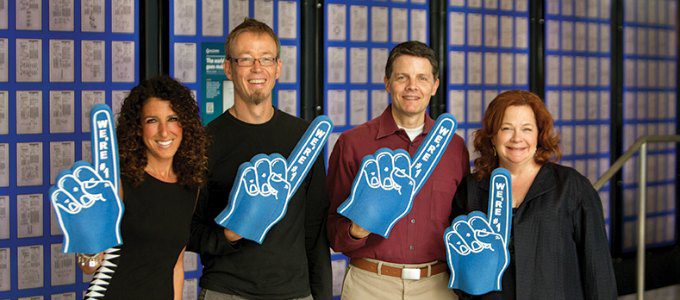From left: Tamar Elkeles, chief learning officer; Geoff Stead, senior director of engineering; Steve Ouellette, senior director of learning; and Rita Buffington, senior director of learning. (Photo by Paul Barnett Photography)
Long before co-founding wireless technology company Qualcomm Inc. in the mid-1980s, Irwin Jacobs immersed himself in learning.
The Cornell University grad taught electrical engineering at Massachusetts Institute of Technology in the late 1950s and early 1960s, eventually heading west to become a professor of computer science and engineering in the earliest days of the University of California, San Diego in the seaside community of La Jolla.
Later, he nurtured his entrepreneurial side, growing the fledgling Qualcomm into one of San Diego’s two current Fortune 500 companies; the other is Sempra Energy Inc. Now 81, Jacobs focuses much of his time and energy on civic endeavors, having relinquished Qualcomm’s day-to-day operations in the mid-2000s.
Yet his legacy as an entrepreneur and an unwavering commitment to education — he’s received numerous academic degrees and accolades — remain pillars of Qualcomm’s success. In fact, the formerly sleepy little campus of UC San Diego where Jacobs once taught now boasts more than 30,000 students — nearly 9,000 of whom study in the aptly named Jacobs School of Engineering.
Perhaps more importantly, some 31,000 Qualcomm employees globally currently reap the benefit of Jacobs’ passion for learning. The Qualcomm Learning Center entered a new era of innovation in 2013, blowing past the notion that learning must follow a rigid schedule documented on an Excel spreadsheet.
Learning leaders recognized that Qualcomm’s business needs are continually shifting, like waves washing over the sand along the beach at nearby La Jolla Shores. Employees constantly challenge themselves, their colleagues and the company by creating fresh approaches to learning, technologies and content.
“We want to create self-sustaining learning,” said Rita Buffington, Qualcomm’s senior director of learning. “We want to get to the point where our employees teach each other. That helps usfocus on high-touch areas like executive coaching.”
The learning center’s key focus is on next-generation learning practices and future learners’ needs. Qualcomm is blending mobile technology with research from the Harvard Graduate School of Education Future of Learning to address the changing world of work, learning and information. Mobile learning is among the strategies, coupled with an expanded social component. While traditional classroom settings and learning methods remain, employees increasingly are getting the latest information and technology from each other.
As proof, 43 percent of Qualcomm employees have accessed its Employee AppStore. More than 50 percent of those users visit the store via mobile devices vs. desktop computers, and have accessed more than 20,000 hours of content.
It’s not just the fresh-faced Qualcomm newbies sponging up all the learning nodes. An impressive 74 percent of vice presidents and above have used the Employee AppStore, too.
Communication techniques employees use outside of work — think Facebook and Pinterest — are sprouting as internally designed learning programs as well, Buffington said.
Piggybacking off that is the use of curated open-source content — in essence, a free gallery to collect, organize and display information on a topic or area of interest.
“We adopted curation early,” Buffington said, adding that the concept came out of models used by retailers Costco and Trader Joe’s. “It’s the consumer experience. People trust those employees; they select the best products and share them with customers. We needed to think about it that way— be more selective, find those open-source nuggets and get them out there.”
The center’s content areas are broad, but can be customized for every learner. Delivered via mobile learning or in a classroom setting, the content targets project teams, business units or geographically based business needs.
Teaming with third-party vendor Pathgather, last year Qualcomm unveiled its learning center portal, which provides users with a personalized, social and interactive experience similar to Facebook, Yelp and YouTube. It’s sort of a DIY content curation that can be shared with others and has gained quick acceptance among employees. More than 50 percent of employees have accessed the portal, with 4,000 employees “following” others.
In his pre-Qualcomm days, Irwin Jacobs co-founded the pioneering high-tech firm Linkabit. In a nod to Jacobs’ trail-blazing past, Qualcomm’s learning center is moving into the future with Thinkabit Labs, a new hands-on classroom that strives to drive innovation and interest in STEM subjects — science, technology, engineering and math — for young students from the poorest schools in San Diego and Santa Clara.
“We know we need more talent, and we need to develop a pipeline,” Buffington said. “The future of learning is important to Qualcomm. We have a highly educated workforce. We’re creating the ability for our employees to get what they need when they want it.”












